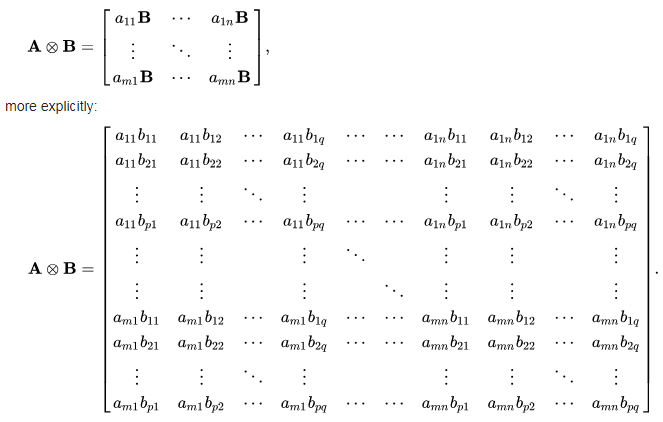NumPy: Compute the Kronecker product of two given mulitdimension arrays
8. Kronecker Product
Write a NumPy program to compute the Kronecker product of two given mulitdimension arrays.
Note: In mathematics, the Kronecker product, denoted by ⊗, is an operation on two matrices of arbitrary size resulting in a block matrix. It is a generalization of the outer product (which is denoted by the same symbol) from vectors to matrices, and gives the matrix of the tensor product with respect to a standard choice of basis. The Kronecker product should not be confused with the usual matrix multiplication, which is an entirely different operation.
If A is an m × n matrix and B is a p × q matrix, then the Kronecker product A ⊗ B is the mp × nq block matrix:

Sample Solution :
Python Code :
import numpy as np
# Create two 1-dimensional arrays 'a' and 'b'
a = np.array([1, 2, 3])
b = np.array([0, 1, 0])
# Display the original 1-d arrays 'a' and 'b'
print("Original 1-d arrays:")
print(a)
print(b)
# Compute the Kronecker product of the arrays 'a' and 'b' using np.kron() function
result = np.kron(a, b)
# Display the Kronecker product of the said arrays
print("Kronecker product of the said arrays:")
print(result)
# Create two 3x3 arrays 'x' and 'y'
x = np.arange(9).reshape(3, 3)
y = np.arange(3, 12).reshape(3, 3)
# Display the original higher dimension arrays 'x' and 'y'
print("Original Higher dimension:")
print(x)
print(y)
# Compute the Kronecker product of the arrays 'x' and 'y' using np.kron() function
result = np.kron(x, y)
# Display the Kronecker product of the said arrays
print("Kronecker product of the said arrays:")
print(result)
Sample Output:
Original 1-d arrays: [1 2 3] [0 1 0] Kronecker product of the said arrays: [0 1 0 0 2 0 0 3 0] Original Higher dimension: [[0 1 2] [3 4 5] [6 7 8]] [[ 3 4 5] [ 6 7 8] [ 9 10 11]] Kronecker product of the said arrays: [[ 0 0 0 3 4 5 6 8 10] [ 0 0 0 6 7 8 12 14 16] [ 0 0 0 9 10 11 18 20 22] [ 9 12 15 12 16 20 15 20 25] [18 21 24 24 28 32 30 35 40] [27 30 33 36 40 44 45 50 55] [18 24 30 21 28 35 24 32 40] [36 42 48 42 49 56 48 56 64] [54 60 66 63 70 77 72 80 88]]
Explanation:
In the above exercise –
a = np.array([1, 2, 3]): This line creates a 1D NumPy array a with elements [1, 2, 3].
b = np.array([0, 1, 0]): This line creates a 1D NumPy array b with elements [0, 1, 0].
result = np.kron(a, b): This line computes the Kronecker product of the two arrays a and b. The Kronecker product is obtained by multiplying each element of the first array with the entire second array. In this case, the result is [0, 1, 0, 0, 2, 0, 0, 3, 0].
x = np.arange(9).reshape(3, 3): This line creates a 3x3 NumPy array x containing elements from 0 to 8, arranged in a 3x3 matrix:
[[0, 1, 2],
[3, 4, 5],
[6, 7, 8]]
y = np.arange(3, 12).reshape(3, 3): This line creates a 3x3 NumPy array y containing elements from 3 to 11, arranged in a 3x3 matrix:
[[ 3, 4, 5],
[ 6, 7, 8],
[ 9, 10, 11]]
result = np.kron(x, y): This line computes the Kronecker product of the two arrays x and y. The result is a 9x9 array formed by multiplying each element of x with the entire y array.
print(result): This line prints the resulting Kronecker product, which is a 9x9 array.
For more Practice: Solve these Related Problems:
- Compute the Kronecker product of two matrices using np.kron and verify the resulting block structure.
- Implement a function that computes the Kronecker product for multidimensional arrays and checks the output shape.
- Compare the Kronecker product of an identity matrix with another matrix to ensure the original matrix is replicated.
- Test the properties of the Kronecker product by verifying (A ⊗ B)(C ⊗ D) equals (AC) ⊗ (BD) for compatible matrices.
Go to:
PREV : Eigenvalues and Eigenvectors
NEXT : Condition Number of a Matrix
Python-Numpy Code Editor:
What is the difficulty level of this exercise?
Test your Programming skills with w3resource's quiz.
